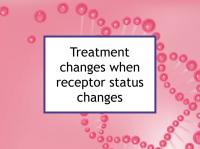Estrogen receptor (ER), progesterone receptor (PR) and HER2/neu (HER2) receptor status each can change as breast cancer progresses. Sometimes there is discordance at initial diagnosis between the receptor status of the primary tumor and lymph node metastases. More often, such changes appear when the cancer reaches an advanced stage. Now a new case report has described multiple receptor changes in one patient over six years which were handled by treatment changes with some success.
Rates of discordance
Discordance between the status of original tumors and corresponding metastases occurs in at least 25% of cases. The available data varies widely. Rates of discordance between primary breast tumors and their distant metastases are summarized below based on published reports to date:
- Change
- ER+ → ER-
- ER- → ER+
- PR+ → PR-
- PR- → PR+
- HER2+ → HER2-
- HER2- → HER2+
- Likelihood
- 5 to 30%
- 3 to 22%
- 19 to 49%
- 4 to 16%
- 4 to 28%
- 1 to 40%
As the table shows, PR status changes are more common than ER changes and changes in HER2 overexpression vary greatly among studies. Loss of receptor expression is more common than gain. One study estimated that ER status changes back and forth throughout tumor progression in 5% of cases.
Receptor changes were met with treatment changes
The case study referenced above describes the history of a women who was diagnosed with Stage IIIA invasive ER+/PR-/HER2- ductal breast cancer at age 58. As time progressed, she first developed a triple negative (ER-/PR-/HER2-) recurrence, indicting a loss of ER expression. She then reacquired ER expression in mediastinal lymph node (in the chest) metastases. In addition, her HER2 status evolved, from HER2- to HER2-low, which also informed treatment selection.
The patient initially was treated with neoadjuvant chemotherapy, bilateral mastectomy and radiotherapy. This was followed by endocrine therapy, immunotherapy, CDK4/6 inhibitors, and antibody-drug conjugates, all of which extended her survival. The authors comment that, given the extended response times and improved tolerability of current breast cancer regimens, accurate receptor assessment is needed so that patients can receive the most optimal treatment.
Please see our article on hormone receptor and HER2 status changes and the discordance tag for more information.
